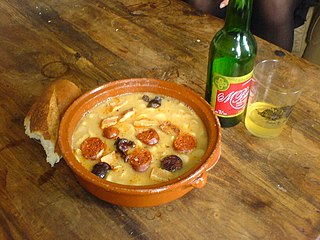Related Research Articles
Romanian cuisine is a diverse blend of different dishes from several traditions with which it has come into contact, but it also maintains its own character. It has been mainly influenced by Turkish and a series of European cuisines in particular from the Balkans, or Hungarian cuisine as well as culinary elements stemming from the cuisines of Central Europe.

Momo is a type of steamed filled dumpling in Tibetan and Nepali cuisine that is also popular in neighbouring Bhutan and India. Momo is usually served with a sauce known as achar influenced by the spices and herbs used within many South Asian cuisines. It can also be cooked as soup versions known as jhol momo where the broth is made from achar using a mixture of tomatoes, sesame seeds, chillies, cumin and coriander or mokthuk from boiling pork/buffalo bones mixed with various herbs and vegetables.

Asturian cuisine refers to the typical dishes and ingredients found in the cuisine of the Asturias region of Spain.
Montenegrin cuisine is a result of Montenegro's geographic position and its long history and tradition.

Thukpa is a Tibetan noodle soup, which originated in the eastern part of Tibet. Amdo thukpa is a famous variant among the Indians ,Nepalese and Tibetans. Thukpa can be prepared in both vegetarian and non-vegetarian variations; the most popular non-vegetarian variation includes chicken. There are numerous varieties of thukpa which includes:

Tibetan cuisine includes the culinary traditions and practices of the Tibetan people in the Tibet region. The cuisine reflects the Tibetan landscape of mountains and plateaus and includes influences from neighbors. It is known for its use of noodles, goat, yak, mutton, dumplings, cheese, butter, yogurt, and soups. Vegetarianism has been debated by religious practitioners since the 11th century but is not prevalent due to the difficulty of growing vegetables, and cultural traditions promoting consumption of meat.
Bosnia and Herzegovina cuisine is balanced between Western and Eastern influences. The food is closely related to former Yugoslav, Middle Eastern, Mediterranean, Austro-Hungarian and other Balkan cuisines.

Bhutanese cuisine employs much red rice, buckwheat, and increasingly maize.

Cheese soup is a type of soup prepared using cheese as a primary ingredient, along with milk, broth and/or stock to form its basis. Various additional ingredients are used in its preparation, and various types and styles of cheese soup exist. It is a part of some cuisines in the world, such as American, Colombian, Mexican, Swiss, French, and Tibetan cuisines. Mass-produced cheese soups may be prepared with the addition of food additives to preserve them and enhance flavor. A list of cheese soups is included in this article.
In Tibetan cuisine, Tu is a cheese cake, made with yak butter, brown sugar and water, made into a pastry.

Oyster stew is a stew made with oysters. It is popular in the United States and in The Gambia.

Guthuk is a stew soup which has various types of ingredients like beans, vegetables, meat etc, or left over harvested grains is used for preparing
References
- 1 2 Li, Tao; Jiang, Hongying (2003). Tibetan customs. 五洲传播出版社. p. 37. ISBN 978-7-5085-0254-0 . Retrieved 5 August 2011.